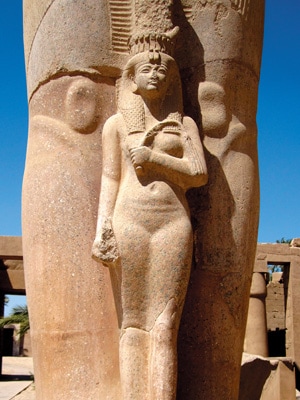
Footloose In Egypt
One city is as different from another as the past is from its present
Alright in Alexandria
The receptionist has throat cancer and must keep a finger on the tiny hole at the top of his chest when he speaks, “Welcome to...” and as his fingertip slips there’s a deflated wheeze instead of “Alexandria”. My room is one of those typical budget accommodations with a ‘sideways sea view’, meaning that I glimpse a strip of the Mediterranean from behind the back of the more posh 1920s’ Hotel Cecil (where a literary hero of mine, Somerset Maugham, once stayed). My head is boiling over with preconceived imagery of the colourful city.
“A fecund desert of human loves littered with the whitening bones of its exile,” wrote Lawrence Durrell in his Alexandria Quartet. Michael Palin referred to it as “Cannes with acne”. E.M. Forster confessed, “It is only at sunset that Egypt surpasses India — at all other hours it is flat, unromantic, un-mysterious and godless.” Perhaps the last time anybody said anything nice about Alexandria was in antiquity when Strabo described a magnificent city that rivalled Rome itself.
Each was, of course, motivated by his times. The Roman geographer Strabo, for example, moved to Alexandria to work at the famous library in the 20s BCE, shortly after Cleopatra’s suicide, when Egypt was added to the Roman kitty. He described the licentiousness of the Ptolemies that ruled prior to the takeover, everything that Egypt had to offer from Nile fishes to barley beer, and how Alexandrian streets were crowded with Ibis birds — a great nuisance. The British wits had their agendas too, as their empire had a commercial and strategic interest in the Suez Channel. So Forster was a Red Cross volunteer in the First World War and Durrell a press attaché during the second. Forster wrote the intriguing Alexandria: A History and a Guide (1922), which concerns itself with the sights that aren’t visible to the eye, or as he said, “I’m constructing by archaeological and other reading an immense ghost city.” Durrell described the city’s underbelly and his four novels are understandably not so popular here; none of the bookshops I visit have copies.
Forster’s guidebook project seems to have been a bit of a cover so that he could stalk a handsome tram-conductor, travelling miles by night trams, hanging around the Ramel Station hoping for a glimpse of Mohammed. Eventually the affair bloomed to be the only full-fledged one he ever experienced. Towards the end, Mohammed fell ill with consumption (and died in 1922). Forster — keeping one tram-ticket as a cherished memento — returned to Dewas, in present-day Madhya Pradesh, to work on his masterpiece A Passage to India. One of the central characters in the novel, Aziz, is apparently based on the tram-conductor.
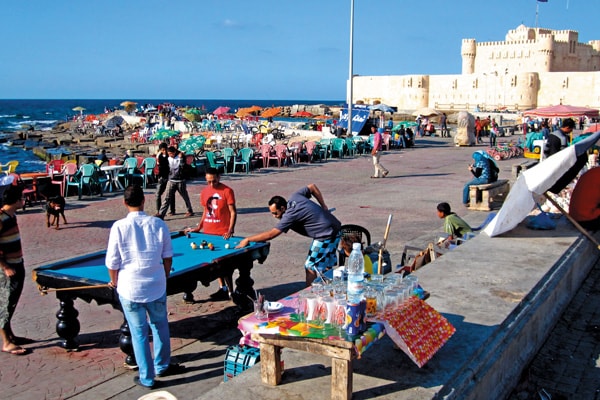
Poolside Menu Shooting pools at the foot of the fabled lighthouse in Alexandria
Apart from British writers, the ‘fecund desert’ of Alexandria attracted tens of thousands of Italians, Greeks and Jews as well as people from all parts of the crumbling Ottoman Empire, in a rare mix of east and west. There was a strong French connection too, discernible today in the francophone shop signs. The chanteuse Edith Piaf came in 1949, entertaining the French community, hanging out at Elite, the old-fashioned bar standing on the wedge-shaped corner on Safia Zaghloul Street.
The 1952 revolution changed all that. The nationalisation of the Channel led to the Suez Crisis and a heavy-duty stand-off between Egypt, Israel, France and Britain, resulting in the expulsion of foreigners; so now, that Alexandria too — the open cosmopolitan city — primarily exists in the mind.
Ancient Alexandria’s library was supposed to collect the knowledge of the world (it even housed ancient Indian manuscripts), an early offline version of Google Books. Forster also tells us that its employees had to serve the Ptolemaic royals by writing elegies to order. Which sometimes presented delicate problems, like when the bald queen Stratonice asked for a poem praising her hair. The library is long gone, burnt down book by book by various invaders; today’s modern replacement is flashy, but not half as exciting as the idea of the original.
The grand lighthouse, in its day the tallest tower in the world (taller than the UB Tower in Bangalore today), was visible 50 kilometres out to sea. It collapsed in the 14th century and was last seen by Ibn Battuta. The causeway that connected the mainland to the island of Pharos has silted over into a peninsula, and in its quaint al-Anfoushy neighbourhood you find the best seafood joints. Topmost is Ahmed Elaa’s Fish Restaurant, run by Ahmed’s descendants, right next to the fish market. You pick your fish from their own shop (rate as per weight), and then sit down to drool while the meal is cooked. At a bakery where I saw all customers feasting on deadly-looking meat pies, the old-fashioned baker sent me to the old-fashioned butcher next door to get the mince: Even the pies here are assembled in a pre-modern DIY fashion.
The city centre remains pleasantly old-fashioned. Unlike other Egyptian cities, where souks are geared towards pushing souvenirs, the bazaars are very traditional. If you wish to carry home Arabic style-caviar, go to Sultan al-Fasigh, the little fish shop on Sharia Ismai’l al-Mohafza (near the railway station). The battered trams central to Forster’s love life are the oldest in Africa; horse-carriages are still common, and not just as a tourist thing; and patisseries retain Art Deco interiors.
And at the colonial railway station clocks have stopped at different hours.
Chaos in Cairo
Cairo is two hours by train, but a different world: A Middle-Eastern metropolis that is extra noisy now that its denizens have spearheaded a successful revolution. Every day I come across some demonstration or the other in Tahrir Square, down the street from my hotel. The hawkers offer January 25 merchandise, from stickers with Mubarak with a noose round his neck to coffee mugs with the print ‘Tahrir Square, I was there’.
Many of the art listings in the Daily News are to do with the January 25 events — photo exhibitions, installations and dance performances — and every first Saturday of the month Cairo’s arts community gathers in front of the Ministry of Culture to organise an unofficial free all-day-all-night festival, something unthinkable just a year ago. One night, walking back after a few beers in the culture-vulture bar el-Horryia (which means ‘Freedom,’ and where patrons look extra-happy), I see boys dancing on the roofs of cars that slowly roll down the street, honking horns in hypnotic rhythm.
The Egyptian Museum doesn’t seem to have been damaged in the revolution — it’s just naturally rundown, and combines one of the best collections in the world with the worst possible showcasing. Apart from the mummies and Tutankhamen’s treasures (including a loaf of bread 3,330 years past its use-by date), don’t miss: Hall 14 (the world’s oldest portrait collection, the Fayyum Paintings); Hall 32-33 (models from tombs, such as a miniature Pharaonic beer brewery); and Hall 53 (perversely mummified animals).
Out in Giza the tourism trade is in overdrive, squeezing what cash can be had out of the trickle of tourists. My taxi is waylaid by touts at a crossing kilometres before the pyramids; they are so aggressive that I must throw myself out in order to not get abducted. As I trot towards the pyramids that I glimpse above the rooftops, I am chased by camel-drivers desperate for business. The ticket office closes about a minute before I reach it, and the staff are unhelpful. Guidebook statements regarding closing times just mean that people will be ushered out by that time; the inlet shuts whenever they please. This appears to be part of the business plan, because visitors are then made to pay touts 350 Egypt Pounds (EGP) for an hour on a camel that’ll take you inside, even if the place is ‘shut.’ After protracted bargaining, a guy offers to take me inside on foot against EGP 100, which sounds okay, until I realise that it doesn’t include the baksheesh to a variety of walkie-talkie-toting officials (but does involve a two kilometre walk through desert heat to the backdoor of the pyramids).
But when I finally stand between the pyramids of Cheops and Chephren, two of the world’s most massive buildings, dating back some 4,500 years, I cannot but feel a little impressed. I’m almost alone, save for Abdul the tout and a Japanese couple who have rented two EGP 350 camels to get in. It is that evening hour which they say is the best for viewing the pyramids, when they look like mountains of gold.
“Happy now?” Abdul asks.
My throat is completely dry.
“Yes, happy,” I croak.
Luxury-shopping in Luxor
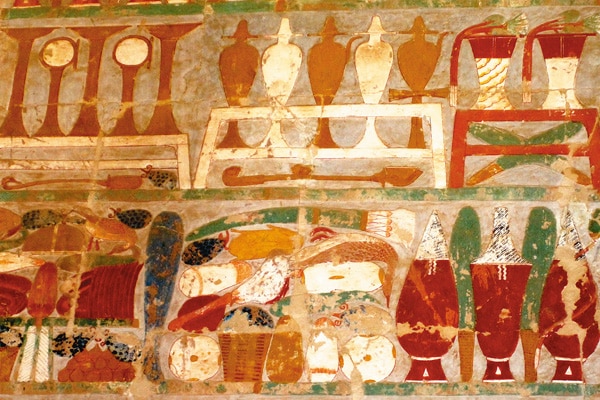 Royal Treats Queen Hatshepsut’s shopping list from Punt, as seen on the wall of her funerary temple in Luxor.
Royal Treats Queen Hatshepsut’s shopping list from Punt, as seen on the wall of her funerary temple in Luxor.
Up the Nile is Luxor, where I’ve booked myself a room on the west bank, in Sheikh Aly’s House, a small inn dating back to the 1920s, when archaeologists used to stay here. Any other time it would be hard to secure a booking, because it is right between the Valleys of the Kings and Queens. Post-revolution, it is almost empty and a room (with AC and attached bath) can be had for EGP 85 a night. The drawback is that there aren’t many restaurants nearby; except for the lovely café in the celebrated Egyptologist Howard Carter’s house, down the road. Carter was the guy who discovered Tutankhamen’s tomb and unleashed the Curse of the Mummies.
The Nile is half-an-hour’s walk away and the ferry across costs one pound. Luxor town, on the east bank, is now pleasantly deserted, with just a bunch of travellers. At the stupendous Karnak temple I walk alone through massive pillared halls, except for a busload of German package tourists being herded through. For shopping the tourists’ souk offers unbeatable value; the shopkeepers are so desperate when they see me that they beat down their own rates from hundreds of pounds to nothing. For fixed-price shopping, the place is Gaddis & Co, originally the photo studio attached to the old Winter Garden hotel, which also stocks books and souvenirs. Among their unique products are the black-and-white photo enlargements by Gaddi himself, one of the first Egyptian photographers.
My most satisfactory meal in Egypt is served in a tiny mess near the railway station. The Akher Sa’a is run by a veiled woman and her jolly husband; she cooks, he serves. But what catches my attention are the fish pots stewing slowly on the grill. They’re served with Egyptian pulao, flat breads, salads and some delicious Arabic mush. When I ask for a recipe, aunty says it’s nothing special, just a mix of fish, vegetables and ‘Egyptian masala.’ Her choice of words reminds me that the Indian spice route passed through here, and probably affected Egyptian cuisine.
The historical highlight, however, is the temple of the first woman pharaoh, Hatshepsut, who out-pharaohed most of the male pharaohs. The grand three-storey complex features 3,500-year-old paintings documenting, in hieroglyphs and lavish colour-pictures, a c.1493 BCE summer trip to the fabled land of Punt. It is thought that Punt is present-day Somalia or perhaps Eritrea, but more distant locations have been posited, such as Syria and even India, because the produce of Punt includes typically Indian export products such as incense, spices, monkeys, cinnamon, ebony, ivory and other sweet and exotic things. (Another theory is that Punt was a trading post for Indian goods.)
This painted wall could well be the oldest travel reportage in the world and the shopping holiday must have been one of the highlights of Hatshepsut’s life, considering how much space it is given: Ships being readied at a Red Sea harbour, the journey, with stingrays and turtles swimming around the five-ship flotilla, and finally Punt, where the sailors are served beer by traders holding up incense jars.
The most remarkable detail: Right outside the temple complex are the roots of two shrivelled trees — most likely myrrh but possibly sandalwood — which were brought from Punt and planted by the Queen herself.
Racing to the Red Sea
I decide to follow Hatshepsut’s trail to al-Quseir, the ancient harbour on the Red Sea. Quseir simply means ‘the shortest route’ as it is just 180 kilometres from the Nile. This route was used by the Romans when Indian goods were carried by mules across the desert and transhipped upriver to the Mediterranean Sea. They built watchtowers, forts and water stations, because it took five nights to cross the desert (travellers would sleep through the heat of the day).
The route tempts me, but there is a hitch. It is prohibited to foreigners. For security reasons the police insist that tourists travel by another route, north towards the resort town Hurghada.
However, during my days in Luxor I’ve made contacts, and the driver Hany has a plan. He offers to ‘borrow’ a civilian car, less likely to be stopped than a taxi, with which we’ll bluff our way through the check-posts. If we’re stopped, I am to tell the cops that we’re buddies and we go together to Quseir every year, “no problem”.
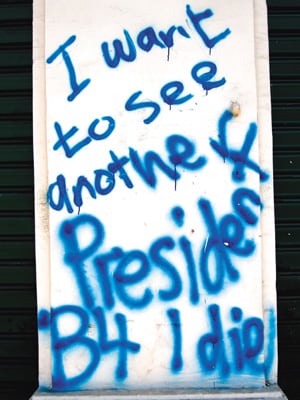 At the Qift check-post, bored policemen stare at the car catatonically without stopping us. From then on Hany floors it to see if he can give the speedometer a heart attack. At 200 kmph the result is that we cross the entire desert in 50 minutes.
At the Qift check-post, bored policemen stare at the car catatonically without stopping us. From then on Hany floors it to see if he can give the speedometer a heart attack. At 200 kmph the result is that we cross the entire desert in 50 minutes.
Luckily there’s not much traffic. Al-Laqeita, the only town marked on my map, is a mere cluster of houses. Then I spot the Roman watchtowers, but at that speed my photographs are nothing but an impressionistic blur. “Sorry, you’re not afraid of speed? I should have asked you before, but I forgot,” says Hany, as he slows to a sedate 140 kmph to negotiate one of the few bends in the desert road. Like many other young Bedouin, he is happy to have traded the camel for a faster vehicle. “But don’t worry; only trouble is if the cops catch us. The speed limit is 60 so we’d have to pay a load of fines.” He laughs as we pass a sign notifying drivers about the speed camera.
Image: Zac O’Yeah
Post Tahrir Square The newly won right to express your thoughts freely is used everywhere, all the time. This, on a Cairo wall
Our luck runs out about 10 kilometres from the coast, as Hany is busy telling me Mubarak jokes. We’re stopped at a massive police control. They drag Hany into the station and I have to stand with my luggage in the desert while the car is checked for contraband. Luckily the cops don’t know English so I am cool, but Hany is being shouted at. After an hour or so, and a bribe equivalent to roughly 300 rupees, Hany is off the hook.
He drives cautiously as long as we’re within the series of roadblocks, murmuring that if I want to get back to Cairo from here we could start out at 4 a.m., when the cops are asleep, and we’d reach before 8 a.m. Then he says that Egypt needs a new ‘manager’ like Qaddafi to set things straight. He couldn’t care less about the revolution and he floors the pedal again.
Quseir is centred on a rundown harbour, where boats lie capsized in the mud. The minuscule Corniche seaside promenade has a handful of deserted cafes and two rental shops for diving equipment bearing witness to more ambitious times. There’s a crossroads with a petrol pump and a café where unemployed Egyptians smoke hookahs all day. In the next street there are souvenir shops surrounding the only tourist site in town, the 16th century Ottoman citadel. The tourism information booth is deserted but there’s a museum with some basic data about Quseir.
The first known trading fleets sailed from here c.2200 BCE, but the harbour peaked during the Roman era, then known as Myos Hormos, ‘Mussel Harbour.’ According to sources 120 ships sailed for India each season — following the monsoon winds — primarily to fetch pepper, a favourite Roman condiment. With the fall of the Roman Empire business slumped but when Mecca became a place of pilgrimage, Quseir, with the shortest route to Mecca, was a winner. Decline became inevitable in 1497, after Vasco da Gama established the sea route to Asia, around Africa’s southern-most point; then the Suez Channel in 1869 made Quseir’s claim of ‘shortest distance’ redundant.
Lately Quseir has tried to reinvent itself as a diving destination and so I head up to the beach strip north of town, where three resorts have come up, the Radisson, the Mövenpick and the Flamenco. A special offer lands me an ocean view room with balcony and meals for €49. An hour later I am floating over the coral reef, staring at fish in amazing colour schemes.
In the afternoon I walk out into the Wadi Quseir al-Qadim, inland from the hotel. Once a grand lagoon fed by several rivers, this was the harbour through which much of the ancient trade passed; now it’s an empty desert valley. The only memory of the nearby ocean is the salt crunching underfoot.
But archaeologists went rapturous upon discovering a massive garbage dump dating back 2,000 years. Walking down a slope, I stumble on heaps of crushed amphorae, stuff that would be inside glass cases in museums elsewhere. Well, what did I expect? If 120 ships went to India every year (not to mention other possible destinations), loaded with Italian and Greek wines in amphorae, one might expect some spillage. Furthermore the archaeologists found bits and pieces of Roman ships — everything virtually mummified by the desert air, and embedded in tidy time layers in the sand — and pot shards with Tamil writing.
Here and there are foundations of buildings too, quays, guest houses with the remains of a big amphora used for water storage, a posh ruin known as The Villa, which may have been the harbour master’s residence, another house might have been the local bakery because there is a mortar for grinding and the base of an oven.
There was even a small Roman military garrison of some 50 to 60 men posted here, and I can’t stop myself from speculating that they were probably getting hooked on the masala dosas that the South Indian sailors cooked. Maybe that is how the Europeans got their crepes?
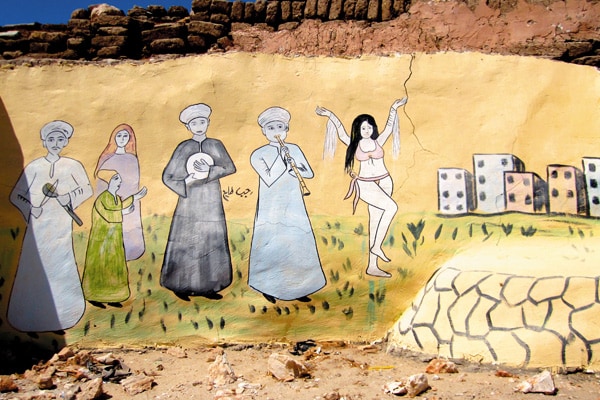
Wall Art Adorable kitsch on the wall of an alabaster souvenir shop in Luxor
Trip planner
Getting there: Qatar Airways has flights for around Rs. 35,000. Within Egypt, buses are efficient, flexible and cheap. AC buses run to schedules, minibuses on demand. It is usually possible to turn up at the station and board a bus.
When: Travel season is October–May. Given the current situation, check dates for elections and political developments before you travel. But tourism pressure is low right now, which means great deals on hotels and smaller crowds at important tourist sites.
Currency: One Egyptian pound (EGP) is roughly Rs. 7.50.
Stay: A decent budget AC room with attached bath generally costs around EGP100. Luxury hotel rates (usually quoted in Euros) are typically €50–100. Budget hotels always have free WiFi, but not always breakfast. Expensive hotels usually offer Net connectivity at exorbitant rates, but some beach resorts give extremely good value packages including meals.
Eat: A tasty meal can be had for EGP10–30 even in a big city like Cairo, but expect to pay EGP60–100 at fancier restaurants. At simpler eateries, any dish you order usually includes lots of bread, pulao, salad, soup and other side dishes. Alcohol is generally only served in tourist restaurants and upmarket hotels, but Egyptian red tea is a splendid alternative beverage.
Read: Egyptian tourist offices aren’t a very good resource; the best info is on wikitravel.org/en/Egypt with individual entries for many cities and frequently updated travel advisories. Other good sources: touregypt.net and, if you’re into history, houseofptolemy.org
See Zac O’Yeah’s recommendations for each city at business.in.com
(This story appears in the 30 November, -0001 issue of Forbes India. To visit our Archives, click here.)
